Steinmetz solid
A Steinmetz solid is the solid body obtained as the intersection of two or three cylinders of equal radius at right angles. It is named after mathematician Charles Proteus Steinmetz,[1] who solved the geometric problem of determining the volume of the intersection, though these solids were known long before Steinmetz studied them.
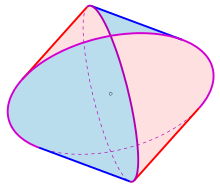
The intersection of two cylinders is called a bicylinder. Topologically, it is equivalent to a square hosohedron. The intersection of three cylinders is called a tricylinder.
Each of the curves of the intersection of two cylinders is an ellipse.
The bicylinder is known as a mouhefanggai in Chinese (for two square umbrellas,[2] written as 牟合方蓋). Archimedes and Zu Chongzhi had already calculated the volume of a bicylinder.
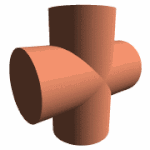
Bicylinder
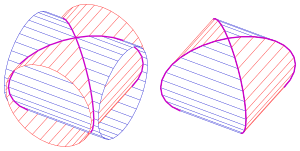
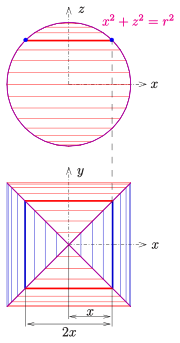
A bicylinder generated by two cylinders with radius has the
- volume
and the
- surface area
- .
Proof of the volume formula
For deriving the volume formula it is convenient to use the common idea for calculating the volume of a sphere: collecting thin cylindric slices. In this case the thin slices are square cuboids (see diagram). This leads to
- .
It is well known that the relations of the volumes of a right circular cone, one half of a sphere and a right circular cylinder with same radii and heights are 1 : 2 : 3. For one half of a bicylinder a similar statement is true:
- The relations of the volumes of the inscribed square pyramid (), the half bicylinder () and the surrounding squared cuboid () are 1 : 2 : 3.
Using Multivariable Calculus:
Consider the equations of the cylinders:
The volume will be given by:
With the limits of integration:
Substituting, we have:
Proof of the area formula
The surface area consists of two red and two blue cylindrical biangles. One red biangle is cut into halves by the y-z-plane and developed into the plane such that half circle (intersection with the y-z-plane) is developed onto the positive -axis and the development of the biangle is bounded upwards by the sine arc . Hence the area of this development is
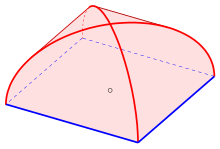
and the total surface area is:
- .
Derived solids
A bisected bicylinder is called a vault,[3] and a cloister vault in architecture has this shape.
Alternate proof of the volume formula
Deriving the volume of a bicylinder (white) can be done by packing it in a cube (red). A plane (parallel with the cylinders' axes) intersecting the bicylinder forms a square and its intersection with the cube is a larger square. The difference between the areas of the two squares is the same as 4 small squares (blue). As the plane moves through the solids, these blue squares describe square pyramids with isosceles faces in the corners of the cube; the pyramids have their apexes at the midpoints of the four cube edges. Moving the plane through the whole bicylinder describes a total of 8 pyramids.
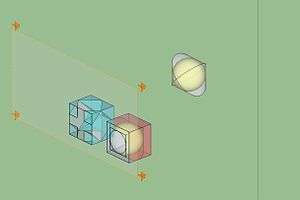 Zu Chongzhi's method (similar to Cavalieri's principle) for calculating a sphere's volume includes calculating the volume of a bicylinder.
Zu Chongzhi's method (similar to Cavalieri's principle) for calculating a sphere's volume includes calculating the volume of a bicylinder.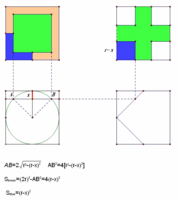 Relationship of the area of a bicylinder section with a cube section
Relationship of the area of a bicylinder section with a cube section
The volume of the cube (red) minus the volume of the eight pyramids (blue) is the volume of the bicylinder (white). The volume of the 8 pyramids is: , and then we can calculate that the bicylinder volume is
Tricylinder
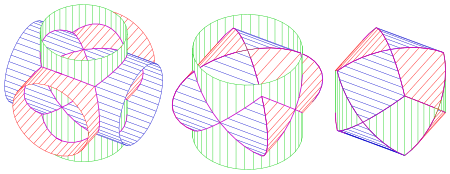
The intersection of three cylinders with perpendicularly intersecting axes generates a surface of a solid with vertices where 3 edges meet and vertices where 4 edges meet. The set of vertices can be considered as the edges of a rhombic dodecahedron. The key for the determination of volume and surface area is the observation that the tricylinder can be resampled by the cube with the vertices where 3 edges meet (s. diagram) and 6 curved pyramids (the triangles are parts of cylinder surfaces). The volume and the surface area of the curved triangles can be determined by similar considerations as it is done for the bicylinder above.
The volume of a tricylinder is
and the surface area is
More cylinders
With four cylinders, with axes connecting the vertices of a tetrahedron to the corresponding points on the other side of the solid, the volume is
With six cylinders, with axes parallel to the diagonals of the faces of a cube, the volume is:
See also
References
- Howard Eves, Slicing it thin, in: David Klarner, The mathematical Gardner, Wadsworth International 1981, S. 111
- http://thesaurus.maths.org/mmkb/entry.html?action=entryByConcept&id=3736%5B%5D
- Weisstein, Eric W. (c. 1999–2009). "Steinmetz Solid". MathWorld—A Wolfram Web Resource. Wolfram Research, Inc. Retrieved 2009-06-09. Check date values in:
|date=(help)
Bibliography
- Apostol, Tom M.; Mnatsakanian, Mamikon A. (2006). "Solids circumscribing spheres" (PDF). American Mathematical Monthly. 113 (6): 521–540. doi:10.2307/27641977. JSTOR 27641977. MR 2231137. Archived from the original (PDF) on 2012-02-07. Retrieved 2007-03-25.
- Jan Hogendijk (2002). "The surface area of the bicylinder and Archimedes' Method". Historia Mathematica. 29 (2): 199–203. doi:10.1006/hmat.2002.2349. MR 1896975.
- Moore, M. (1974). "Symmetrical intersections of right circular cylinders". The Mathematical Gazette. 58 (405): 181–185. doi:10.2307/3615957. JSTOR 3615957.